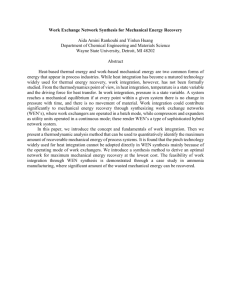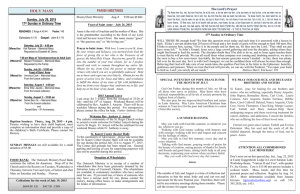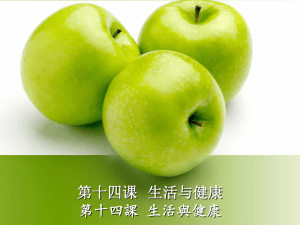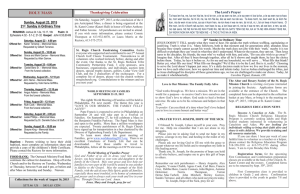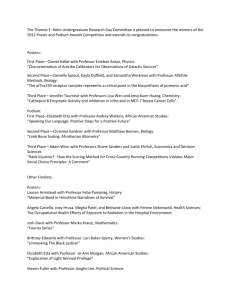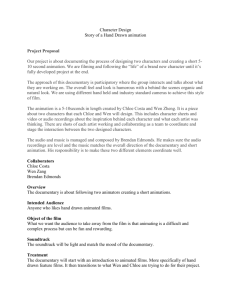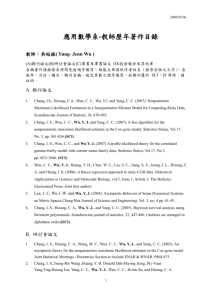Teacher Guide - Carol Antoinette Peacock
advertisement
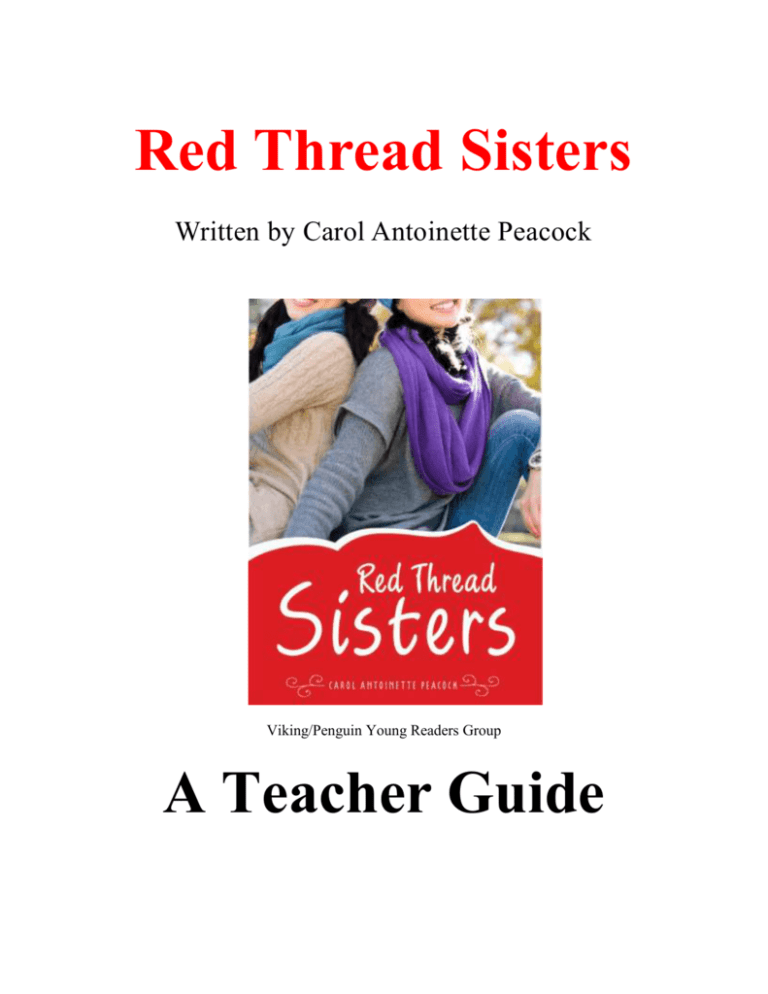
Red Thread Sisters Written by Carol Antoinette Peacock Viking/Penguin Young Readers Group A Teacher Guide Dear Teacher, I have always held teachers in highest regard because so many of my teachers made such an impact on my own life. Recently, my husband changed careers, from being a journalist to a history teacher for the Boston City Public Schools. For the first time, I realized the endless amount of preparation time teachers put into their work, the exhausting long days, the challenges of the classroom. Author and reading specialist, Tracie Vaughn Zimmer, and I wanted to make a Teacher’s Guide that would help to you. We have included a range of lessons, curriculum connections, and activities, so that you can pick best what applies to your planning and your students’ needs. We have tied the English lessons to the new Common Core for English Language Arts, the National Council for Social Studies’ National Curriculum Standards, the National Science Educational Standards and the American Association for Health Education Comprehensive School Education Standards. In Appendix B, we link each of the lessons and activities here to the specific requirements listed in these standards. I hope you enjoy teaching Red Thread Sisters. It’s a book about multicultural differences, the power of family and the meaning of friendship. I also hope you can find ways to use my book to enrich and assist you in your fine work with your students, who benefit from your teaching everyday. Sincerely, Carol Antoinette Peacock, MSW, Ph.D. www.carolpeacock.com 2 TABLE OF CONTENTS 1. Introduction to Book and Author………………………………………………………………….…6 2. Red Thread Sisters Bookmark…………………………………………………………………….…..7 3. Pre-Reading and Discussion Questions……………………………………………………………8 LANGUAGE ARTS 1. Identifying the Theme………………………………………………………………………………....….9 2. Identifying Similes………………………………………………………………………………..……9-10 3. Write Your Own Similes………………………………………………………………………………..10 4. What Are Metaphors?………………………………………………………………………………10-11 5. Create Your Own Metaphors……………………….………………………………………………..12 6. Whose Point of View?....................................................................................................................12 7. Reading Fluency………………………………………………………………………………………….13 8. What Family Means…………………………………………………………………………………….13 9. A Short Story of Your Own……………………….………………………………………………….13 10. Research: Digging Deeper……………………………………………………………….........13-14 11. New Vocabulary………………………………………………………………………………………..14 SOCIAL STUDIES: CULTURE l. Invite a Guest Speaker from Another Culture……………...................................................15 2. Hold a Multicultural Luncheon……………………….........................................................15-16 3. Exercise: Multicultural Cooking…………………………………………………………………...16 4. Exercise: Multicultural Art and Decorations………………………………………………….16 3 5. Exercise: A Chinese Lantern…………………………………………………………………………..17 6. Exercise: A Good Luck Hand (Khamsa)………………………………………………………….18 SOCIAL STUDIES: PEOPLE, PLACES & ENVIRONMENT l. Mapping…………………………………………………………………………………………………..19-20 2. Where in China did Wen Live?..................................................................................................20 SOCIAL STUDIES: POWER, AUTHORITY AND GOVERNANCE 1. Social Change: What about Shu Ling?.....................................................................................21 SCIENCE: PERSONAL HEALTH l. Exercise, Exercise, Exercise!.................................................................................................21-22 HEALTH: HEALTH PROMOTION 1. How Others Impact Young People’s Health: Crossword Puzzle…………………………………………………………………………………....22-23 2. Answers to Crossword Puzzle……………………………………………………………………….24 HEALTH: HEALTH ENHANCING BEHAVIORS 1. How did Wen manage stress? ……………………………..........................................................25 2. How do you manage stress?................................................................................................25-26 HEALTH: INTERPERSONAL COMMUNICATION SKILLS TO ENHANCE HEALTH l. Expressing Needs Through “I Statements”………………………………………………….26-27 2. Was Wen bullied?....................................………………………………………………………………..28 4 ART 1. A Picture of Friendship………………………………………………………………………………….28 2. Trying Chinese Calligraphy……………………………………………………………………….28-29 MUSIC l. Hold a Multicultural Concert………………………………………………………………………….30 SERVICE LEARNING 1. Sponsor an Orphan’s Education……………………………………………………………………..30 2. Gifts of Hope from Medical Care to Special Needs……………………………………………31 3. Needed Toys and Supplies for Orphanages……………………………………………….31-32 4. Honor Someone with an Orphanage Donation Card………………………………..…32-33 APPENDIX A: Further Reading……………………………………………………………………..34-35 APPENDIX B (For Teachers) Lesson Plans Linked to National Standards…….…36-38 5 ABOUT THE BOOK RED THREAD SISTERS By Carol Antoinette Peacock Viking/Penguin Group ISBN-10: 067-00103862 ISBN013: 978-0670013869 Wen has spent most of her life in a Chinese orphanage, where the only person she would call "family" is her best friend, Shu Ling. All Wen has ever wanted is to be adopted. But when Wen's lucky day finally comes, and she is whisked off to a Boston suburb, she realizes she had no idea what she was getting into. Learning English is hard, and using that English to make friends with the girls at school, or to tell her new parents that she loves them, seems almost impossible. But the worst part is knowing that Shu Ling remains back at the orphanage, alone. Before she left, Wen made a promise to find Shu Ling a family of her own. But promises aren't always so easy to keep, and time is running out….” About the Author Carol Antoinette Peacock has published 6 children’s books, including a Mommy Near, Mommy Far and Pilgrim Cat, a book about a cat coming to the New World on the Mayflower. Additionally, she has written a middle grade guidebook for children handling grief and loss, and a chapter book about how a young boy copes with a new diagnosis of diabetes. Red Thread Sisters is based on her experiences as an adoptive mother, who worked with older children at her daughters’ orphanage. Besides being a writer, she is a practicing psychologist, where she uses her black Lab as her co-therapist. You can visit her at www.carolpeacock.com 6 MAKE A RED THREAD SISTERS BOOKMARK Cut out the two sides of the Red Thread Sisters bookmark below, and then paste them together. Use the bookmark to keep your place, as you read the book. 7 PRE-READING Do you know any Asian people or people from other cultures? In your own classroom, how many students represent different ethnic backgrounds? Do you think students in your school are open to students of other races or cultures? How do you think people from other countries feel about life in America? The heroine is adopted into another family. Can friends sometimes be as close as family? What makes a family a family? Today there are many kinds of families. What types of families do you know? DISCUSSION QUESTIONS 1) After reading Chapter One, list everything you know about the girls. 2) Wen is more conflicted about leaving the orphanage than she ever thought she’d be. Why is it so more difficult? 3) Describe Wen and Shu Ling’s friendship. Cite examples from the text to back up your statements. 4) Compare Wen’s life in the orphanage to her new life in the States. 5) Describe Wen’s family through her eyes. Find specific examples. How does Wen’s initial perception of her family influence her actions? 6) How is language is a barrier for Wen, in understanding what’s going on around her? Give examples. Not understanding English also prevents Wen from expressing herself. Which would you find most difficult? Why? 7) Wen worries a great deal about being sent back to China. Why? Give examples that make her feel like this is a real possibility for her. 8) How do the other kids at school treat Wen? With whom does she make connections? Why is Michelle mean to her? 9) Why was Wen’s idea of asking her new family to also adopt Shu Ling suddenly far more complicated than she planned? What will she do to find her friend a new family? 10) Why does Wen feel bad about learning to ride her new bike with Hannah? Do you think she and Hannah will become best friends too? Why or why not? 11) How does Wen describe her friend to make her more appealing for adoption? What does this tell us about Wen? 12) Why does Wen hold back in her new relationships with her mother and Hannah and her sister, Emily? 13) When does Wen finally become brave enough to ask her family to adopt Shu Ling? Why do you suppose she does it then? 14) Why is Wen’s excitement about Shu Ling’s adoption suddenly crushed? How does Wen convince Shu Ling to change her mind? Cite the points she makes in her argument. 8 CURRICULUM CONNECTIONS: ENGLISH ARTS Reading Literature 1) Finding the Theme Books are built around certain ideas or themes. A theme can be seen as the “message” of the book. Often, books have more than one theme. What are the themes in Red Thread Sisters? Themes aren’t always easy to identify. Sometimes the way a character speaks about a certain topic gives us clues about the theme. Take three post-its and write down three quotes, or statements Wen feels strongly about. Then as a class, arrange all your yellow post-its on a class mural. Walk along the mural, taking notes on the statements your classmates have found. As a class, discuss possible themes of Red Thread Sisters. 2) Identifying Similes The word simile comes from a Latin word meaning sameness, or the same as. A simile is the comparison between two unrelated nouns (person, place, thing, or idea) using "like" or "as." Writers use similes when they describe things by comparing them to other things. For example, instead of saying someone runs fast, you could say she runs like the wind. Red Thread Sisters uses many similes. In the beginning of the book, Wen is looking for Shu Ling. “Then she found her friend, crouched like a cricket on a stack of tires.” p. 3. Later, her first night in America, “Wen sank into her soft bed, her sheets as fragrant as the peonies that grew behind the orphanage.” p. 31 Similes are easy to recognize. They have two grammar patterns. One is “as (something) as (something else)” and the other is “(something) like (something else.) The words “as” or “like” tell us we are making a comparison. Connect the similes. Pick a phrase from the left column and draw a line to the word that completes the correct simile. 9 1. As cute as … a rock 2. As quiet as… a feather 3. As hard as … a glove 4. It fits like … a button 5. As cold as…. a baby 6. As light as a mouse 7. As flat as … pie 8. As sweet as…. an owl 9. She slept like ice 10. As wise as a button 3) Write Your Own Similes Write some similes of your own. Pick three from the list below or choose your own. Try to make your similes fresh so that they create a vivid image in the reader’s mind. Then share your similes with the class. Simile # l My brother is as……… Simile #2 My dog is like…….. Simile #3 My bedroom is as…….. Simile #4 The sunrise was as……….. Simile #5 The students in the classroom were like………. 4) What are Metaphors? A metaphor is the use of words that say one thing is like another thing. A metaphor shows that two people, places or things that on the surface are very different are similar in one important way. The reader or listener must find the connection, creating a vivid picture in his or her mind. Metaphors often come as a surprise. Writers use metaphors to create a fresh, unexpected image for the reader. 10 Read the sentences below. Then list the qualities that would explain why one word is being compared to another, seemingly different word: 1. There was hardly any pizza left! We all could have had more, if Heidi hadn’t been such eaten so much! How would you describe how Heidi ate? Selected Similarity (Metaphor) Ate too much Ate more than her share Ate fast HOG Metaphor: Heidi, a hog, devoured all the pizza. 2. Pete was always cheerful, even when he first entered a room. How would you describe how Pete? Selected similarity (Metaphor) Always happy Smiled a lot Bright expression Warm to people Sunshine Metaphor: A ray of sunshine, Pete burst into the room 11 5) Create Your Own Metaphors Working in pairs, fill out the table below, making up your own metaphors Word you’re describing (e.g., person, place, or object you know well) Qualities of this word you are describing Something completely DIFFERENT from this word that has the same qualities Make a sentence using the metaphor you just created. 6) Whose Point of View? 12 The narrator of Red Thread Sisters tells us the story from Wen’s point of view. Imagine that you are Wen’s new mother, new father, or Emily. Describe to the class how you would perceive Wen’s first days in your home. How would you feel? How would you interpret Wen’s behavior? From the text, cite specific examples of Wen’s words and behaviors and describe how you would react, from the other person’s view. 7) Reading Fluency Pick one of your favorite parts of Red Thread Sisters and be prepared to read this passage aloud to the class. 8) What Family Means In chapter twenty-eight Wen describes to Shu Ling what being a family means to her: “No. Being with a family is better because if you get lost, they drive you around in their car until they find you. If you feel sad, they try to cheer you up, even if they don’t really know what’s wrong. If you get sick, they sit by your bed and take care of you. And if things get hard, like maybe there’s less money, they still love you no matter what, because they’re your family.” Describe what it’s like to be in your own family. State your opinion clearly. What do you do for each other? How do you know your parents love you? Provide logically ordered reasons that are supported by specific details. Finish with a strong concluding statement. 9) A Short Story of Your Own Write a short story based on your own, based on some of the ideas Red Thread Sisters explores. Topics you may want to address might be friendship, getting used to a new place, moving, or families that change, whether through birth of a new child, adoption, divorce, or death. Orient the reader with an opening that introduces the situation and characters. Take some time thinking about your characters. Who are they? What are their special personality traits. How do your characters respond to events that happen? Be sure to use vivid dialogue and detailed description. Provide a conclusion that follows from the experiences and events of your story. 13 10) Research: Digging Deeper Drawing from the list of suggested reading, write a research paper that addresses one of the following topics. 1) In the beginning, Wen has trouble adjusting to American culture. How do people from other countries “fit in” to American life? What parts are most difficult? Provide facts, quotes and other concrete information to support your topic. Be sure to provide a strong concluding summary. 2) Wen and Shu Ling were “waiting children” in a Chinese orphanage. Are there “waiting children” in other countries’ orphanages? You may want to focus on one country or several. What obstacles do these children face? Provide facts, quotes and other concrete information to support your topic. Be sure to provide a strong concluding summary. 3) Wen and Shu Ling refer to “Lunar New Years.” What other festivals does China celebrate? You may also want to research the festivals of another country. Provide facts, quotes and other concrete information to support your topic. Be sure to provide a strong concluding summary. 11) Some New Vocabulary All readers run into words that are new for them as they go. Many words can be figured out by the clues in the sentences around them (called context clues). As you read the novel, try to find at least five new words. Then, fill out the chart below: New word: The sentence its used in: The clues to its meaning: A definition in your own words: 14 Curriculum Connections: Social Studies CULTURE 1) Invite a Guest Speaker from Another Culture Wen comes to the United States to be exposed to a whole new culture. Do students in your class represent other countries or cultures? Take a poll. Ask students to share information about their own country of origin. Invite a guest speaker from another ethnic background to tell the class more about the beliefs, values and ways of life from his/her culture. To make the speaker feel more welcome, you might make a special dish or decoration from the speaker’s country of origin. 2) Hold A Multicultural Luncheon In the United States today we are a multicultural society and it is important that we understand each other culture’s values and traditions. As a class, pick a date for a multicultural lunch, as a way to better understand and celebrate diversity. 15 The teacher divides the class into groups of three or four students and randomly assigns each group to one of the following regions: South America, Central America, Africa, Asia, the Middle East and Europe. From the National Geographic website, pick a country you want to study. http://education.nationalgeographic.com/education/mapping/outline-map/?ar_a=1 As a group, make a poster about this country’s culture, showing its geography, food, festivals, traditions, beliefs, religion and way of life 3) Exercise: Try Multicultural Cooking Then prepare a dish from that country and prepare it for then luncheon. The following websites may be helpful: http://recipes.sparkpeople.com/greatrecipes.asp?food=multicultural+recipes+for+ kids http://www.world-recipes.info/ http://multiculturalrecipes.blogspot.com/ 4) Exercise: Multicultural Art and Decorations In order to decorate the classroom for the luncheon, students may make decorations representative of their country or region. Besides the examples here, you can find more ideas on: http://www.kinderart.com/multic/ http://www.makingfriends.com/world.htm 5) Exercise: Make a Chinese Lunar Lantern 16 Supplies: Colored paper (construction paper or gift wrapping) Scissors Glue, tape or a stapler 6) Exercise: Make A Good Luck Hand (Khamsa) The khamsa is a symbol of good luck from Morocco, Africa. This good luck hand has 17 been used as a symbol in Northern Africa for centuries and is often made of precious metal, like silver. You can make this version out of paper or aluminum foil. Khamsa means “five” in Arabic. Supplies needed: Construction paper or aluminum foil Scissors Glue Crayons, markers or paint Optional: sequins, glitter, glitter glue Before your multicultural luncheon, decorate the classroom and then enjoy the dishes. Each group should take a turn, spending about 10 minutes, sharing with the rest of the class what they have learned about the country and culture they have studied. They should also explain what they have represented on their poster. Curriculum Connections: Social Studies 18 People, Places and Environment Satellite Map of China 1) Mapping. China has a land area of 3,691,502 square miles (9,596,960 square kilometers), making it the world's third largest nation. It borders thirteen countries, including Russia and Mongolia to the north, India to the southwest, and Myanmar, Laos, and Vietnam to the south. To the east, it borders the Yellow Sea, the South China Sea, and the East China Sea. The climate is extremely diverse, ranging from tropical in the south to subarctic in the north. In the west, the land consists mostly of mountains, high plateaus, and desert. The eastern regions are characterized by plains, deltas, and hills. The highest point is Mount Everest, on the border between Tibet and Nepal, the tallest mountain in the world. (source: http://www.everyculture.com/Bo-Co/China.html ) Make a three dimensional map of China, using clay, to show the topography. Make a poster map, using colors to show temperature ranges, both in the winter and the summer. Make a poster map, using colors to show population density. Make a mobile or other 3 dimensional map to compare the size of China with the size of the United States. Some good websites to start your research include: http://www.asianinfo.org/asianinfo/china/geography.htm http://www.map-of-china.org/ 19 http://www.sacu.org/china.html 2) Where in China did Wen Live? Geographical Details Red Thread Sisters was set in a very specific part of China. Can you find clues throughout the text to identify where in China Wen’s orphanage was located? In pairs, search the text and note your clues in the table below. Then, as a class, review your findings. Using the websites listed earlier as well as books from the library to match the clues with where Wen’s orphanage might have been located. Discuss the possibilities and back up your conclusion with facts. Clues about where Wen’s orphanage was located. Temperature in the winter (very cold, temperate?) Temperature in the summer (very hot, temperate? Regional crops (what the children ate) Landscape Proximity to ocean In what section of China do you think Wen lived?________________________ If you have your best guess, email the author at carolpeacock@verizon.net and tell her what you think. Carol will write your class back, to tell you how you’ve done and answer any other questions you have. 20 Curriculum Connections: Social Studies Power, Authority and Governance 1) Social Change: What if Shu Ling attended your school? Imagine that Shu Ling attended your school. With her limb difference, could she walk up and down stairs, climb bleachers, etc.. As a class, tour your school to see if all areas are handicapped accessible. Take notes on areas where you school needs improvement. Make a list along with an action plan and discuss the steps you will take. Will you prepare a written document or position paper? Who will you meet with first? An individual or groups? Suppose the improvements cost money? What will you suggest? If you determine that your school is completely handicapped friendly, divide into groups and do similar assessments of local community institutions, such as stores, parks, and other buildings. Discuss your findings with the class and identify one or more facilities that need improvements to be handicapped accessible. What will you do next? Will you need a position paper? Who will you speak with first? Outline all the steps you will take. Curriculum Connections: Science Personal Health 1) Exercise, Exercise, Exercise! “Regular exercise is important to the maintenance and improvement of health.” The benefits of physical fitness include maintaining healthy weight, having energy and strength for routine activities, good muscle tone, strong heart/lungs, and improved mental health. Personal exercise, especially developing cardiovascular endurance, is at the heart of physical fitness.” (National Science Education Standards) 21 Compare the exercise levels of the main characters in Red Thread Sisters. Who got the most physical exercise? Who got the least? Connect each character on the left to the impediments that may prevent that person from getting regular exercise, on the right. Discuss ways some of the characters who exercise least might overcome their obstacles. Wen Shu Ling Sedentary life style Worried exercise will give an unwanted body builder image. Doesn’t see any value in physical exercise Emily Physical Disability Mr. McGuire Divorced parents’ schedules make coordination exercise difficult to organize. Mrs. McGuire Doesn’t like physical exercise. Hannah Not enough money for physical activity classes. Michelle Has never learned certain physical activities. Refuses to do exercises with certain people. Too busy to exercise. Worried might sweat or not look good while exercising. No routine or scheduled time for exercise. Curriculum Connections: Health Health Promotion 1) Family and Peers Impact on Young Peoples’ Health Often, family and peers influence the health of pre-adolescents and adolescents. Complete the crossword puzzle below to show how both in the orphanage and in the United States, family and peers impacted the health of the young people in both settings. 22 How Family and Peers Impact Young People’s Health 4 1, 6 5 2 7 3 Across 1) What the girls introduced family. to Wen one holiday night. 8 Down 4) Where Wen’s father took the whole 5) How Wen tried to warm Shu Ling’s cold leg 2) What Wen and Shu Ling both tried to feed extras. 6) The part of Wen Shu Ling leaned on. 7) Emily wanted to teach Wen this activity. 3) Wen’s father cooked these for Wen her first breakfast the 8) What Shu Ling fed Wen, her first day at 23 orphanage. Answers to the Crossword Puzzle 4 M 1,6 s c h D o 2 n a l d 5 s o a k e e s l e t g 8 s s o h o w d u 7 l d e e e d r s d d i n 3 e g o u p 24 Curriculum Connections: Health Health-Enhancing Behaviors 1) How Did Wen Manage Stress? People handle stress in many ways. Finish the chart below to compare the ways to see a pattern in how Wen managed stress. Stressful Situation What Wen Did to Handle Stress At the orphanage, Wen learns that Shu Ling cannot go to school because of her disability. The other girls make fun of Shu Ling in the shower. The first night in America, Wen gets lonely in her bed. One day after school, Wen misses Shu Ling very much. Wen realizes the McGuires cannot adopt Shu Ling and she’ll need to find another family. Wen finds Shu Ling online but feels the description is too brief. The countdown is almost over. Wen learns that Shu Ling has changed her mind. Does Wen show a pattern about how she handles stress? Discuss your findings in class. 2) How Do You Manage Stress? 25 How can people, especially young people manage stress? Brainstorm with the class all the possible ways to manage stress. Write the ideas on a large sheet of paper and post the list on the wall. Make a poster or collage to show the ways you handle stress. The teacher may have each student present his/her poster to the class. From all the ideas, pick 2 new ways you may try, the next time you feel stressed. Here are some helpful resources: http://www.webmd.com/balance/stress-management/stress-management-topicoverview http://www.mayoclinic.com/health/stress-management/MY00435 Curriculum Connections: Health Interpersonal Skills to Enhance Health 1) Expressing Needs, Wants and Feelings through “I Statements” In the beginning, Wen couldn’t express her needs, wants or feelings because she couldn’t remember English. Later, she couldn’t ask her family to adopt Shu Ling because she thought she would be sent back to the orphanage. Over time, as Wen grew to trust her new family, she was able to express her needs better and communicate, both verbally and nonverbally. Everyone can use practice expressing needs, wants and feelings. An important tool is the use of “I Statements.” An “I statement” means you begin your sentence using an “I” feel,” thus taking ownership of your own response to want, need, or feeling. It is a non-threatening way of communicating. Learning to make I statements helps you avoid starting your expression with the word “You,” which can become critical and make For more information about I statements, refer to: http://www.humanpotentialcenter.org/Articles/IStatements.html http://www.compassioncoach.com/how_and_when_to_use_i_statements http://www.communicationandconflict.com/i-statements.html 26 I statements can be used to express sadness too. Think of a situation where a person wants something, needs something, or has a feeling he/she would like to express. Then, using I statements, draw a cartoon to show how use of I statements helps that person communicate. Share your cartoons with the class. 27 2) Was Wen bullied? Discuss the role that bullying has in the novel. Do you think Wen is bullied by her peers? Is Wen excluded by her peers? Why? Is it because she is from another culture? Because she is new? Or because she’s made friends with Hannah? Is there a difference between bullying and excluding? How can a school community prevent both? Act out one of the scenes from the book where bullying/exclusion is an aspect but rewrite script change to handle it in a more respectful way. Make posters about preventing bullying in your school. Curriculum Connections: Art 1) A Picture of Friendship Create a collage, drawing, or painting that best represents the relationship between Wen and Shu Ling. In an artist’s statement, explain why you chose the images that you did and how you used color, shape and texture to add depth to your work. 2) Chinese Calligraphy Wen and Shu Ling write to each other in calligraphy. Shu Ling’s characters are “as delicate as the tracks of tiny birds.” Explore the beautiful art of Chinese Calligraphy. Begin your exploration at the Smithsonian Institute: http://www.asia.si.edu/explore/china/calligraphy/ Also see http://depts.washington.edu/chinaciv/callig/7calmodn.htm http://www.npm.gov.tw/exh99/writing9907/ http://education.asianart.org/explore-resources/background-information/introductionchinese-character-and-brush-strokes Now try your hand at practicing some calligraphy of you own. 28 Now Try Your Hand at Your Own Chinese Calligraphy Source: El Alma de la Raza Series, 2004 Denver Public Schools 29 Curriculum Connections: Music 1) Hold a Multicultural Concert What role did music play when Shu Ling sang Wen lullabies at night, in the orphanage? Does music ever help you? Listen to some traditional Chinese music here: http://www.sinohits.net/music/index.htm Does anyone in your class play a musical instrument? Have these students practice a song from another culture. Then schedule a multicultural concert. You may want to invite anther classroom to your performance. Curriculum Connections: Service Learning 1) Sponsor a Child’s Education and Change This Orphan’s Future Through Love Without Boundaries, you can sponsor an orphan’s education for as little as $20 a month. Can you, your family and friends raise enough money to sponsor a child for a year? Go to http://www.lovewithoutboundaries.com/programs/education/sponsor-achild/ to see photos of these children and the ways your sponsorship could change their lives. Plan ways to raise funds for this, or other projects. Will your fundraiser be held at school or in the community? Brainstorm a list and then pick a class fundraising project, with steps to implement your fundraiser. You may need to divide up into committees to be sure all tasks are covered. Make posters to advertise your event and raise awareness of orphanage needs. 30 2) Gifts of Hope, from Medical Care to Special Needs Care Holt International offers a range of donating to children, with a range of contributions that would make a difference. For instance, visit https://www.holtinternational.org/gifts/catalogue12.php#tabs-4 to see how you can prevent children from deadly diseases. If you were moved by the children waiting at Wen’s orphanage, you might be especially interested in Medical Procedures for Children Give a gift that lasts a lifetime! Many of the children relinquished into Holt's care have disabilities or special medical needs. Your gift of a cleft lip and palate repair or surgery for a congenital heart condition or other medical conditions can change a child's life forever. Donation Amount: $300 Also at: https://www.holtinternational.org/gifts/catalogue12.php#tabs-4 3) Special Toys and Supplies for Orphanages Half The Sky encourages people who can make modest donations to purchase toys and classroom supplies for the children in orphanages. See what gifts are needed at http://www.kintera.org/site/c.fwJUK9OZJnI8G/b.8072221/k.8C4F/Shop_to_Help.htm See some examples on the next page. 31 A Shelf Full of Books $25 Blocks and Bouncy Balls $25 Chest of Costumes $100 4) Honor Someone Special with an Orphanage Donation Card The next time you want to say happy birthday, thank someone, or honor who they are, you can purchase a beautiful and meaningful orphanage donation card from Love without Boundaries. A minimum donation of $10 is suggested. http://www.lovewithoutboundaries.com/programs/other-projects/gift-memorial-cards/ 32 Front: "Hope and healing for orphaned children. Every child deserves to experience love and be treated with dignity." Inside: "A donation has been made in your name to Love Without Boundaries. This donation will allow even more children to have a second chance and to know that they truly matter to this world." 33 APPENDIX A: BOOKS FOR FURTHER READING Multicultural Books about Adjusting to a New Culture Abdel-Fattah, Randa, Ten Things I Hate about Me, Orchard Books, May 2010 Alexie, Sherman The Absolutely True Diary of a Part Time Indian, Little Brown, 2007 Bruchac, Joseph, The Warriors, Darby Creek Publishing, 2003 Buss, Fran Leeper, Journey of the Sparrows, Puffin 2002 Chapman, Fern Schumer, Is it Night or Day? Farrar, Straus and Giroux, March 2010 Crew, Linda, Children of the River, Laurel Leaf; Reprint edition (August 1991) Danticat, Edwidge, Behind the Mountains, Scholastic Books, 2004. Gallo, Donald. First Crossing: Stories about Teen Immigrants, Candlewick, 2007. Kadohata, Cynthia, Kira-Kira, Antheneum, 2004. Kidd, Diana, Onion Tears, Orchard, 1989. Lin, Grace. Year of the Dog. Little Brown, 2006. Lombard, Jenny, Drita, My Homegirl, Perfection Learning, 2008 Marsden, Carolyn. The Gold-Threaded Dress, Candlewick 2002. Na, An. A Step from Heaven, Speak, 2003 Park, Linda Sue, Project Mulberry, Clarion 2005. Ryan, Pam Munoz, Esperanza Rising, Scholastic, 2000. Senzai, N.H., Shooting Kabul, Simon and Schuster, July 2011 Shea, Pegi Deitz, Tangled Threads, Clarion Books, 2003 Sheth, Kashmira, Blue Jasmine, Hyperion, 2004. Soto, Gary, Taking Sides, Harcourt 1991. Thanha Lai, Inside Out and Back Again, HarperCollins (February 22, 2011) Yang, Dori Jones, The Secret Life of Gina Zhang, East West Insights, 2011 Yang, Gene Luen, American Born Chinese, Square Fish, December 2008 Yep, Lawrence, The Star Fisher, Puffin, 1992 Williams-Garcia, Rita, One Crazy Summer, Amistad, December 2011 Warren, Andrea, Escape from Saigon: How a Vietnam War Orphan Became an American Boy, Square Fish, 200 Books about Adoption and Adjusting to a New Family Kelliher, Theresa, Ed., Snowflakes, a Flurry of Adoption Stories, Tender Loving Communications, January 2010 Krementz, Jill. How It Feels to be Adopted, Alfred Knopf, New York, 1994. MacLachlan, Patricia. Baby, Random House, New York, 1993. Partridge, Elizabeth, Dog Tag Summer, Bloomsbury Childrens, March 2011 Perkins, Mtali, Moonsoon Summer, Delacourt Books, August 2004 Williams, Laura. Slant, Milkweed Editions, October 2008 Books about the Power of Family Curtis, Christopher Paul, Bud not Buddy, Yearling, January 2002 Creech, Sharon, Walk Two Moons, HarperTeen, December 2003 34 Hunt, Lynda Mullay, One for the Murphys, Penguin Young Readers Group, 201 Park, Linda Sue, A Single Shard, Clarion Books, April 2001 Patterson, Katherine, The Great Gilly Hopkins, HarperCollins, 1987) Woodson, Jacqueline, Peace, Locomotion, Putnam Juvenile, January 2000 35 APPENDIX B FOR TEACHERS Lesson Links to The Common Core State Standards Initiative for English Language Arts, The National Council for Social Studies’ National Curriculum Standards for Social Studies, The National Research Council’s National Science Education Standards, and Joint Committee on National Health Standards Health Education Standards’ National Health Education Standards. The Common Core State Standards Initiative for English Language Arts http://www.corestandards.org/ The National Council for Social Studies’ National Curriculum Standards for Social Studies http://www.socialstudies.org/standards The National Research Council’s National Science Education Standards, http://www.nsta.org/publications/nses.aspx Joint Committee on National Health Standards Health Education Standards’ National Health Education Standards. http://opi.mt.gov/PDF/Health/NHES.PDF Common Core State Standards Initiative for English Language Arts Discussion Questions SL.5.1 (Speaking & Listening; Comprehension and Collaboration) 1). RL.5.1 2) RL.5.2 3) RL.5.2. 4) RL.5.3 5) RL.5.6. 6) RL.5.1 7). RL.5.1 8) RL.5.1 9) RL.5.5 10) RL.5.3 11) RL.5.2 12) RL.5.2 13) RL.5.2 14) SL.5.3 1) Finding the Theme RL.5.2 36 2) Identifying Similes L.5.6 3) Write Your Own Similes L.5.6 4) What are Metaphors? L.5.6 5) Create Your Own Metaphors L.5.6 6) Whose Point of View? RL.5.6 7) Reading Fluency RF.5.4 8) What Family Means W.5.1 9) A Short Story of Your Own W.5.3 10) Research: Digging Deeper W.5.7 11) Some New Vocabulary L.5.4 The National Council for Social Studies’ National Curriculum Standards for Social Studies Culture 1) Invite a Guest Speaker from Another Culture (Curriculum Standard l: Culture, Knowledge #5, Process #1 p. 95) 2) Hold A Multicultural Luncheon (Curriculum Standard l, Culture: Process #2, Product #2, p. 95) 3) Exercise: Try Multicultural Cooking (Curriculum Standard 1, Culture: Knowledge #1, p. 95) 4) Exercise: Multicultural Art and Decorations (Curriculum Standard 1, Culture: Knowledge #1, Process #2 p. 95) 5) Exercise: Make a Chinese Lunar Lantern (Curriculum Standard 1, Culture: Knowledge #1, Process #2, p. 95) 6) Exercise: Make A Good Luck Hand (Khamsa) (Curriculum Standard 1, Culture, Knowledge #1, Process #2, p. 95) People Places and Environment 1) Mapping. (Curriculum Standard 3, Knowledge #9, Process #1, p. 101) 2) Where in China did Wen Live? Geographical Details (Curriculum Standard 3, Knowledge #1, Knowledge #2, p. 101) 37 Power, Governance and Authority 1) Social Change: What if Shu Ling attended your school? (Curriculum Standard 6, Knowledge #5, Products #2, #3, #4, p. 110) The National Research Council’s National Science Education Standards 1) Exercise, Exercise, Exercise! (Content Standard F, Science in Personal and Social Perspectives, Personal Health, p. 168) Joint Committee on National Health Standards Health Education Standards’ National Health Education Standards Health Promotion 1) Family and Peers Impact on Young Peoples’ Health (Standard 1, Performance Indicator 4) Health Enhancing Behaviors 1) How Did Wen Manage Stress? (Standard 3, Performance Indicator 7) 2) How Do You Manage Stress? (Standard 3, Performance Indicator 7) Interpersonal Communication Skills to Enhance Health 1) Expressing Needs, Wants and Feelings through “I Statements” (Standard 5, Performance Indicator 3) 2) Was Wen bullied? (Standard 5, Performance Indicator 4) Tracie Vaughn Zimmer, an author and reading specialist, created this guide. www.tracievaughnzimmer.com/HOME.html 38 Carol Antoinette Peacock added additional materials and exercises. 39
